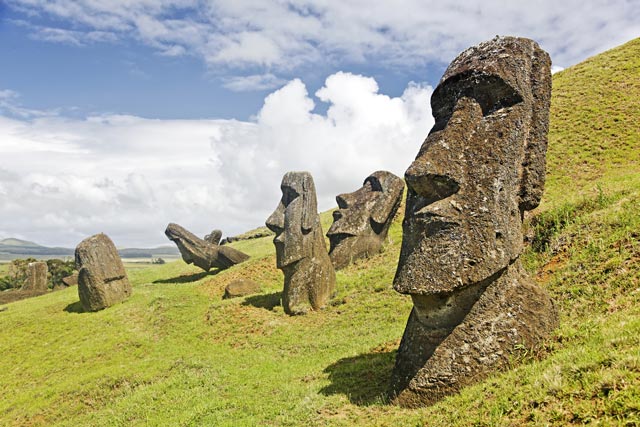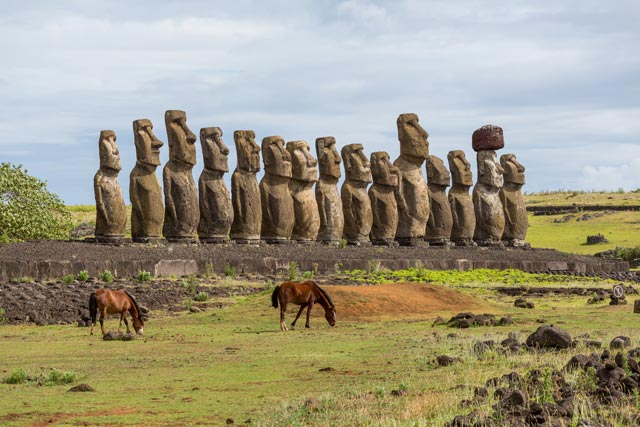All the Facts about Easter Island
(Rapa Nui Facts)
Easter Island Facts – Easter Island roughly covers around sixty-four square miles in the South Pacific Ocean and is located about 2500 miles east of Tahiti and 2300 miles from the Chile’s west coast. Also known as Rapa Nui to its earliest owners, the Easter Island was christened Paaseiland,in 1722 by the Dutch explorers in the honor of the day of their arrival. Easter Island’s main reason to have become so popular is the Easter Island mystery that is yet to be solved with an array of almost nine-hundred giant stone figures that date back to hundreds and hundreds of years ago. The giant figures reveal their makers as engineers and master craftsmen and are different from any other stone sculptures found within the Polynesian culture. Much speculation has been done to find out the exact purpose of the statues, but not much has been discovered to this age.

Easter Island Today
Easter Island, and island measuring fourteen miles long and seven miles wide were a result of a series of volcanic eruptions. Due to its hilly terrain, the island consists of many subterranean caves that extend deeper into the volcanic rock mountains.
Easter Island’s largest volcano is known as Rano Rao with the highest point at 1969 feet above sea level, known as Mount Terevaka. Apparently the island boost no natural harbor, however, ships can still anchor off Hanga Roa on the wet coats, that is the largest village on the island with a population of 3,3000. The island was officially recognised as the World Herger Site by UNESCO in 1995 and is now home to a number of different people with different cultures, mostly to the Polynesian ancestor and the descendants of the Short Ears and Long Ears. The island has turned into a huge platform based on tourism and Spanish is generally spoken around this region.
Easter Island Mystery
The giant Moai statues on the Easter Island have transformed the isolated island into one of the most well-known and mysterious islands. With every passing year, more and more theories come up concerning the Easter Island, the Rapa Nui people and the statutes. Here is one of the most mysterious and fascinating one.
One of the many mysterious of the Easter Island was how the giant stone statues got to their final destination. Paro, the tallest of the statues weights almost eighty-two tons and is insanely hard to move so how did it reach its final resting position?
In the 80s, many scientists and researchers tried to recreate some of the giant statues and tried to move them using certain tools that the ancient people had at their disposal; however, it was almost impossible to do so. However, in contrast, the Rapa Nui people claim that the statues walked by themselves with the help of magic.
The Easter Island’s site is different from any other ancient ruins in the world due to its mysteries that around the giant statues and their makers. Were the giant stone figures, shrines, gods or conduits of heavens? How were they moved? What do they represent? Why are there no trees in the surrounding? Until today, no one has been able to find out who built these statues, why and how did they get there.

When to Visit the Easter Island?
The giant stone structures are beautiful works of art, carved out of volcanic rock during the eleventh and fourteenth century by the Polynesian settlers. The tall figures consist of unsmiling, long faces, hawk-like noses and brooding eyebrows. They can either enthrall or alienating, depending on the light, angle, your mood and especially, the weather.7
The island used to be one of the most isolated places on the earth, dotted with volcanoes and sandy beaches. The mysterious and interesting Easter Island facts have turned the place into a World Heritage Site and one of the top tourism spot.
Easter Island is not the place for you if you are interested in lounging around and beaches. The mysterious stone figures are the main reason why so many visitors are drawn to this region. The island is grassy and flat with no theaters, malls or golfing opportunities. The adventure ones can go for surfing or scuba diving. The key attraction is the Easter Island is exploring the monoliths and that is done best on the back of ahorse. The ultimate destination for anyone who is interested is history, ancient culture and getting outdoors. Two of the popular activities near the island is spelunking and hiking through the caves that were created by the flow of lava.
The island is located in the southern hemisphere that means that the seasons there are quite revered. A warmer weather during the months of December to February make is the best time to go to the Easter Island. However, October, November, March and April provide with the opportunity to explore the island in a secluded and less crowded manner.
Easter Island Facts
Want to learn more about the island? Below are some interesting Easter Island Facts that you love to know:
- Easter Island is one of the world’s most popular yet least visited archaeological sites.
- The Island is hilly, small and treeless.
- The ancient names of the Easter Island were ‘Te Pito o Te henua’ which means ‘The Centre of the World’ and ‘Mata Ki Te Rani’ that means ‘Eyes Looking at Heaven’.
- A Duct sea caption, Jacob Roggeveen, gave the island its current name ‘Easter Island’ in 1722.
- The Easter Island most popular feature is the giant stone statues also known as Moai.
- A small number of these statues were once capped with hats or caps of red volcanic stone. The purpose and meaning and how these were capped are still unknown.
- An average Moai states are about fourteen feet and six inches tall and weigh around fourteen tons.
- Researchers to this date are unable to explain the use and meaning of the Moai Statues.
- Only a quarter of the statues were installed with nearly half still remaining at the site and others sitting along the way to their final resting positions.
- Easter Island is about 24.6 Km long, 12.3km I width and with a total area of 3-kilometre square.

Leave A Comment